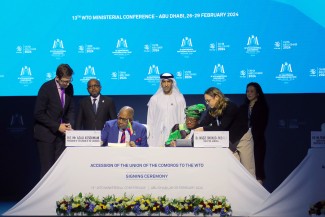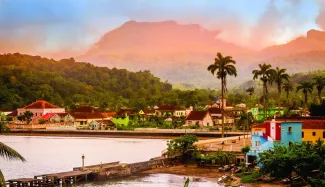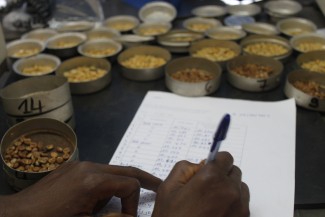New study finds that conservation and tourism can go hand in hand, offering recommendations how to make it so
The COVID-19 pandemic has led to a deep global recession in which much economic activity has declined, and one of the hardest hit sectors is tourism. In tourism-dependent economies in Africa and the Caribbean, for example, GDP is projected to shrink by 12%.
The economic toll is occurring at a time when biodiversity is imperiled globally. The 2020 Living Planet Index reported a 68% average decline in birds, amphibians, mammals, fish and reptiles since 1970. Biodiversity matters because of its intrinsic worth, and because it underpins human wellbeing and supports economic activity. Protected areas, which are key to any global effort to contain biodiversity loss, attract eight billion visitors in a typical year.
How can countries address the intersecting calamities of a pandemic in a time of biodiversity loss? Moreover, can countries afford to bring even larger areas under conservation when the need for economic recovery is so pressing, fiscal spaces are tight and so many development challenges persist?
The Banking on Protected Areas study set out to make the case that this is possible. It assessed the economic impact of protected area tourism on the local economy in five protected areas in Brazil, Fiji, Nepal and Zambia. A model known as LEWIE – Local Economy-Wide Impact Evaluation – was used to measure direct impacts to the economy in the form of visitor spending on park fees, hotels, transport, leisure and recreation, which create employment and support local businesses. Indirect effects occurring when tourism businesses and employees further stimulate economic activity by using the services of other local businesses were also measured.
Findings suggest that by promoting sustainable and inclusive tourism in protected areas, countries can respond to these escalating crises, support recovery from the economic fallout of the pandemic, address longstanding development challenges and conserve biodiversity.
Findings
The study found that tourism in protected areas generates significant income multipliers, a key measure of economic impact. Income multipliers from tourism are greater than one in all country cases, implying that each additional unit of money entering the local economy through tourist spending changes local household incomes by significantly more than one. This finding suggests that local market linkages are strong and amplify tourist spending.
Tourism in protected areas creates significant job opportunities, the study found.Jobs are created directly through tourism activities, and indirectly by stimulating local economies. For example, in Zambia tourism in protected areas generated jobs for 14% and 30% of working age populations around the Lower Zambezi and South Luangwa Parks, respectively. The study accounted for jobs such as hotel employees, tour operators and restaurant workers, and those employed as a result of the increased demand for goods and services catalyzed by tourism in sectors such as retail, services and in some instances agriculture, livestock and fishing.
The study also found that public investment in protected areas pays off and generates high economic returns.Rates of return on government spending are significantly greater than one, making protected areas valuable economic assets. As noted, tourism triggers direct and indirect economic impacts in local economies, which in turn generate rates of return on government spending of between US$6.20 to $28.20 for every public dollar invested. In Brazil, around $460,000 in government expenditures on Abrolhos Marine National Park in 2019 funded mainly staff and administration costs including salaries and transportation, and supported tourism that generated nearly $2.9 million – more than six times the investment.
While the findings of the study cannot be applied to all protected areas, they offer lessons from diverse settings from which policies can be tailored. Central to all efforts, however, is the need to fund and manage protected areas well, promote tourism and diversify its offerings, and share benefits with local communities fairly.
Recommendation 1: Protect the asset
To protect natural assets, it is necessary to formalize their status. Formalization also confers authority on governments to raise environmental standards and reduce the negative impacts of tourism. The study advocates strongly for investment in protected area management; and to accomplish this, it supports the use of financial instruments such as public budgets, as well as innovative mechanisms to tap private sector resources such as conservation trust funds, carbon finance, conservation bonds and collaborative public-private management partnerships.
Successful protected areas must have qualified managers who understand protected area laws and policies, and the business needs of tourism operators and commercial entities.Finally,to make the case for public spending and to aid planning, governments and conservation agencies should regularly assess the impacts of protected area tourism.
Recommendation 2: Grow and diversify the business
In many countries, protected area tourism is focused on a few key locations, which concentrates both positive and negative tourism impacts. In the countries featured in the study, this concentration of visitors at well-known sites makes it important to expand the number of protected area sites, and to select priority sites on the basis of road access, security, biodiversity, landscape attractions and local stakeholder interest in tourism.
Another means to promote tourism in protected areas is through concessioning, which can enhance park operations through managing and financing infrastructure, and providing services such as accommodation, food, merchandise, recreational activities, rental equipment and transport. Similar approaches to outsource tourism development may include leases, management contracts and licensing, and such mechanisms should stipulate key terms and conditions for business operation, such as duration, type of operation, environmental conditions and fees for access.
Recommendation 3: Share the benefits
Sharing benefits with local communities is key to supporting local development and maintaining protected area integrity. Benefits should be distributed fairly by including the poor and disadvantaged, and the study recommends that policies be put in place to enable this.
Advocated benefit sharing approaches include direct and indirect employment, revenue sharing by protected area authorities, revenue sharing schemes from tourism businesses and partnerships, sustainable utilization of plants and animals and shared decision making and capacity building.
Because tourism is the strongest lever for delivering protected area benefits to communities, governments should assist households to participate in the tourism economy through entrepreneurship training, skills development, credit services and logistics. Governments should also support business diversification and local procurement to strengthen linkages in local economies, prevent leakage and increase multipliers. Mitigation and compensation are fundamental to managing human-wildlife conflict and helping to secure support for conservation from local communities who are critical beneficiaries and conservation allies.
Taken together, these three recommendations can enhance development outcomes, secure biodiversity assets and support economic recovery from the pandemic.
---------------
Urvashi Narain is Lead Economist at the World Bank. Phoebe Spencer is a Young Professional at the World Bank.
If you would like to reuse any material published here, please let us know by sending an email to EIF Communications: eifcommunications@wto.org.



